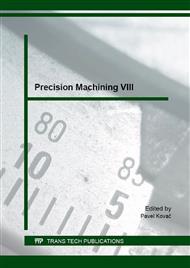p.13
p.19
p.27
p.33
p.39
p.45
p.51
p.57
p.63
Identification of the Minimal Thickness of Cutting Layer Based on the Acoustic Emission Signal
Abstract:
The chip-forming precision machining process plays a significant role in the mechanical technology. In planning of machining operation, it is crucial to supply the information about the possible minimal value of the machining allowance. For the technologist, when planning the machining operation, it is important to define the minimal thickness of cutting layer correctly. This article presents a new method of describing the start of decohesion process in a workpiece, meaning the determination of the minimal thickness of cutting layer based on the AE signal generated in the cutting zone. The research conducted on the turning of an alloy steel and the analysis of the AE signal strength confirmed that the proposed method opens new possibilities in quickening the identification of the minimal thickness of cutting layer under normal machining conditions.
Info:
Periodical:
Pages:
39-44
Citation:
Online since:
February 2016
Authors:
Price:
Сopyright:
© 2016 Trans Tech Publications Ltd. All Rights Reserved
Share:
Citation:


